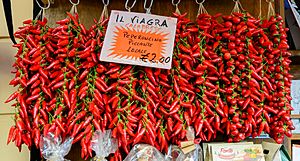Peperoncino facts for kids
Quick facts for kids Peperoncino |
|
|---|---|

|
|
| Heat | |
| Scoville scale | 15,000–30,000 SHU |
Peperoncino is the Italian name for hot chili peppers. These are specific types of chili peppers grown in Italy. A sweet pepper, like a bell pepper, is called peperone in Italian.
Just like most peppers, peperoncini start out green or yellowish-green. As they ripen, they turn a bright red color. In the United States, you often find peperoncini that have been pickled. These are usually a milder type, known in Italy as friggitelli. People often use them whole, sliced, or chopped on sandwiches, in salads, or in Italian-style dishes.
Contents
A Spicy History: How Peperoncino Came to Italy
Peperoncino likely arrived in Italy in the early 1500s. This was after Christopher Columbus brought samples from the New World to Europe in 1492. At first, people thought peperoncino was just a pretty plant. Some even thought it might be poisonous! But soon, it became a popular food in Italian cuisine.
It probably became a common food long before cookbooks mentioned it. This is because early cookbooks were written for rich people. Peperoncino, however, was a cheap and easy food for everyone else.
A scientist named Pietro Andrea Mattioli first wrote about peperoncini in 1568. He noted how much hotter they were than other peppers from Asia. The oldest known recipe using peperoncino is from 1694. It was in a cookbook by the Italian chef Antonio Latini. His recipe for salsa alla Spagnola included chopped peperoncini, tomatoes, and onion. It was mixed with peppermint, salt, and oil, and served as a relish.
Cooking with Peperoncino: Italian Spice

In Italian cooking, peperoncini are used carefully. The flavor is often more important than just making a dish super hot. So, the Scoville scale (which measures heat) is just a general guide. The heat can be quite different between various types of peperoncini.
Peperoncino in Calabria: A Special Spice
Peperoncino is super important in the cooking of Calabria, a region in Southern Italy. In late summer, people string peperoncini on wires. They hang them from buildings to dry in the sun and fresh air. This helps keep them fresh until the next harvest.
People eat them in many ways: whole, fried until crispy, crushed, pickled, or as a powder or paste. A typical peperoncino from Calabria usually rates 15,000 to 30,000 on the Scoville scale.
Some famous Calabrian foods that use peperoncini include:
Peperoncino is also used in dishes from other parts of Southern and Central Italy. For example, it's in the Roman-style arrabbiata sauce. It's also in the Apulian dish "orecchiette alle cime di rapa" (orecchiette pasta with broccoli rabe).
In North America, the crushed red pepper often sprinkled on pizza is usually made from cayenne or jalapeño peppers. However, some special stores sell imported Italian red peperoncino flakes.
Peperoncino Fun: Festivals and Culture
Since 1992, the annual Peperoncino Festival has been held in Diamante, a town in Calabria. The Italian Peperoncino Academy organizes this festival. Now, tens of thousands of people visit it every year!
The festival lasts for four days around the first weekend of September. It takes place on the town's walkway by the sea. There's a big market where local foods made with peperoncini are sold. The festival also hosts a peperoncino-eating contest! Calabrian Chili oil is a popular product that is sold all over the world.

